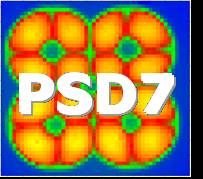Speaker
Mr
Francisco Neves
(University of Coimbra)
Description
Liquid xenon has been recognised as a promising medium for direct
detection of hypothetical
Weakly Interactive Massive Particles. Therefore, investigation of
the response of liquid xenon to
nuclear recoils and g-rays is of primary importance.
In particular, we have recently measured the relative scintillation
efficiencies of liquid xenon for
these two particles by irradiating a liquid xenon chamber with
monoenergetic neutrons and detecting
the scintillation due to xenon recoils from elastic scattering of
the neutrons. The liquid xenon chamber
used in these measurements was equipped with 7 two-inch
photomultipliers (PMTs) in the top of a
cylindrical volume ø17×5.5 cm3 surrounded by PTFE reflectors, which
define the active volume of
the liquid. The scintillation efficiency of liquid xenon for nuclear
recoils with the energy from
140 keV down to 5 keV has been measured. The experimental
uncertainties, among other factors,
include the variation of the signal amplitude with the event
position and some contribution from
multiple scattering in the liquid.
Thus, measurement of the interaction position and rejection of the
events involving two or more
scintillation points would allow the uncertainties to be reduced.
For that, we adopted the maximum
likelihood (ML) method previously employed with success for
scintillation detectors of similar
configuration [1], [2]. Two main difficulties are normally
associated with this method: (i) exact
knowledge of the light collection function throughout the detector
volume is essential, but this
function is difficult to measure or model; (ii) search for the
maximum of the likelihood function is a
heavy computational task.
In the case of our detector, the rather simple configuration of the
device allows to simulate the
light collection using a model with just three free parameters
(reflection coefficient of PTFE,
absorption and scattering lengths in liquid xenon) easily adjustable
to experimental data obtained with
gamma-ray source of 122 keV at various positions. The light
collection template with 2 mm step in
3D has been obtained in this way. The search for the ML was
performed using conventional
techniques such as simplex method, which has been proved to be
efficient for this purpose.
In the case when the scintillation signals are of very low
amplitude, resulting in emission of just a
few photoelectrons from the PMT photocathodes, the single
photoelectron response of the PMTs has
to be taken into account. Therefore, instead of using the Poisson
distribution, as it is normally done,
we implemented ML with Polya distribution.
The developed algorithm was tested with 122 keV g-rays from a 57Co
source placed under the
chamber bottom. An (x,y)-position resolution of s=6.7 mm was
obtained in the xenon layer of a few
mm next to the chamber bottom. In order to assess the resolution in
the whole volume, a number of
fake data sets were produced by Monte Carlo simulation and
reconstruction algorithm has been
applied to them. The results indicate that at 122 keV the resolution
is better than 4-5 mm for the
central region of the chamber (ø80 mm and 40 mm high) and better
than 7 mm in approximately 80%
of the total volume of the chamber. For lower energies, the results
indicate a slow worsening of the
resolution. For example, for 10 keV energy depositions by g-rays,
the position resolution is expected
to become worse by a factor of about 2.
Applying of the developed reconstruction algorithm to the data
obtained with nuclear recoils will
allow the necessary corrections to be introduced and thus to improve
the precision in determining the
scintillation efficiency of liquid xenon to this particles. This
method can potentially be useful for other
liquid xenon purely scintillation detectors that are being developed
for other applications.
[1] W.R. Cook et al., IEEE Trans. Nucl. Sci., NS-32, No. 1, pp. 129-
133 (1985)
[2] D. Gagnon et al., IEEE Trans. Med. Imag., v. 12, No. 1, pp. 101-
107 (1993)
Primary author
Vladimir Solovov
(University of Coimbra)
Co-author
Mr
Francisco Neves
(University of Coimbra)




